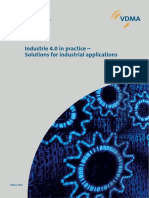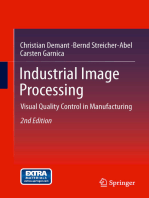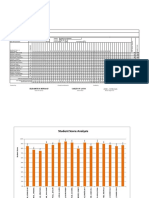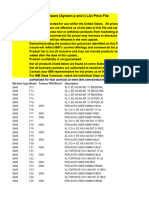Digitization in The Die Casting Technology
Digitization in The Die Casting Technology
Uploaded by
Raviprakash ShankaranarayanaCopyright:
Available Formats
Digitization in The Die Casting Technology
Digitization in The Die Casting Technology
Uploaded by
Raviprakash ShankaranarayanaOriginal Title
Copyright
Available Formats
Share this document
Did you find this document useful?
Is this content inappropriate?
Copyright:
Available Formats
Digitization in The Die Casting Technology
Digitization in The Die Casting Technology
Uploaded by
Raviprakash ShankaranarayanaCopyright:
Available Formats
Digitization in the die casting technology
Posted by Fabio Boiocchi on 8 July 2019 in Foundry · 0 Comments
Different digitization activities enable die casting foundries to make their working processes more
efficient with respect to costs and productivity. Moreover, die casting foundries can exploit the
obtained data and thus open up further business fields.
EUROGUSS 2016
The terms “Digitization” and “Industry 4.0”, which are continuously mentioned in the media, stand,
simply said, for the networking of machines and processes with information and communication
technologies that transmit and process large amounts of data at high speed. A key role here is played
by the internet. The “Forum Industrie 4.0” organized by the German Engineering Federation VDMA
explains on its homepage that digitalization will affect and shape all sectors of industry. The forum, in
which the national foundry industry is represented by the VDMA/BDG working group “Gießerei 4.0”
(Foundry 4.0), offers publications also in English on Industry 4.0 and points out that the one
right solution does not exist: “Be it a revolution or an evolutionary process – each and every company
must find its path to Industry 4.0” [1]. Thus, also die casting foundries are faced with the question of
which digitization activities make individual sense in order to work more cost-efficiently, to remain
competitive and to be able to offer new services and added values.
Digitization of production
Suppliers to the die casting industry provide digital technology that makes the most of machinery
performance. According to Stuart Bashford, who is responsible for the digitization strategy of the die
casting machine construction company Bühler, many of the company’s customers are interested in
digitization activities that can reduce unplanned downtime – and the financial losses linked to it:
“Using our machine-learning algorithms, for example, we can predict where and when failures will
occur. This enables customers to schedule maintenance activities around production schedules
without interruption.” [2] Bühler’s “Predictive Analytics” method is based on the analysis of data which
are supplied from various sensors installed inside a die casting cell and enables to monitor the
performance in real-time. Anomalies, poor performance and developments are revealed and it is
possible to predict where a failure is likely to occur before it actually occurs. The data analysis can be
carried out in the cloud made available from Bühler or in the user’s own network [3]. For all types of
die casting machines, the Cast Quality Control System (CQC) from Electronics GmbH is suitable, for
example. The universally applicable measuring and monitoring system is also based on sensors that
are installed at certain points of the die casting cell and measure various functions such as the
clamping cylinder pressure, the plunger movements, the movements of the mould during the injection
process and the deairing of die casting tools. Via the clamping cylinder pressure, e.g., it is possible to
control the clamping force and to keep it constant with the result that the mould and machine load is
uniform. The machine and process data collected by sensors during production provide not only
indications of the technical condition of production systems, but ultimately help to optimize and
sustainably increase the Overall Equipment Effectiveness (OEE).
Digitizing die cast components
The Fraunhofer Institute for Manufacturing Technology and Advanced Materials IFAM concentrates,
among other things, on combining die cast components with digitization technologies. The
“Casttronics Technology”developed by IFAM includes RFID transponders which are cast directly into
die cast components made from aluminium and a software which can be used to read out, manage
and analyze the transponder data. This makes it possible to permanently mark parts, to protect them
against plagiarism and to follow the entire “supply chain” of the parts from manufacture through use to
recycling [4].
Holistic way of thinking
In order to be able to optimally use digital technologies in a die casting foundry, its business
operations must be holistically captured by figures. This includes transforming data into knowledge,
understanding interrelationships and utilising the findings for the manufacturing process [5]. Franz-
Josef Wöstmann, Head of Department Casting Technology and Lightweight Construction at the IFAM,
goes yet another step further and recommends foundrymen to use Industry 4.0 as a basis for
additional new activities. In an interview he said that only if one can use the data also for further
functions and user benefits after the production, he will be able to differentiate himself from the
market. For this purpose, it is necessary to understand the data that can be obtained, for example,
from components, and to use the interface with customers as a platform for new services. The afore-
mentioned “Casttronics technology” and the associated digitization of the die cast components also
open up the opportunity to exploit their data and to extend the value chain [4].
Dear Herr Thomas Rahn,
Guten Morgan !
I am glad to see your mail. Please find attached a partnership proposal between Fraunhofer-Institut
for Manufacturing Technology and Advanced Materials IFAM & Adhithya Innovations (AI).
I have tried to answer your questions in the proposal. Hope it meets your requirements.
I have a few queries too. Please clarify.
1. I understand that the CASTTRONICS® technology is patented. Is it an
international patent so that no body duplicates the technology in any part of
the world including India?
2. What is the cost of 1 RFID transponder which gets embedded in 1 diecast
component in Euros?
3. What is the cost of the software and the RFID reader to analyse the data
once you capture from the RFID transponders in Euros?
4. CASTTRONICS® technology is it being used by any of the Die Casting companies
in Germany and other countries. Please name a few.
Please feel free to ask any query.
With Warm Regards
Raviprakash
Raviprakash Shankaranarayana
BE, MTech, Six Sigma Master Black Belt
Founder & CEO
Adhithya Innovations
334/335, 6th Main, MS Ramaiah City,
JP Nagar 8th Phase,
Bangalore – 560076
Mobile: +91 9711140306
Landline: +91 80 26485491
Email:raviprakash@adhithyainnovations.com
Website: www.adhithyainnovations.com
You might also like
- Handbook I 4.0 SMARTSystemsDocument387 pagesHandbook I 4.0 SMARTSystemsRaul Gonzales Ruiz100% (1)
- Fundamentals of User-Centered Design A Practical ApproachDocument348 pagesFundamentals of User-Centered Design A Practical Approachthuhuyen1311100% (1)
- Smart ManufacturingDocument7 pagesSmart ManufacturingSajidAliNo ratings yet
- Wang-MBA 6043 - Case StudyDocument11 pagesWang-MBA 6043 - Case Studychetna sharmaNo ratings yet
- Industry 4.0Document6 pagesIndustry 4.0Amit100% (1)
- Industrie 4.0 in Practice 2016Document58 pagesIndustrie 4.0 in Practice 2016Carol100% (5)
- The Fourth Industrial Revolution DemystifiedDocument8 pagesThe Fourth Industrial Revolution DemystifiedZainabNo ratings yet
- Industrial Ethernet Book May 2013Document88 pagesIndustrial Ethernet Book May 2013Juan Sánchez LópezNo ratings yet
- ImplementationofIndustry4 0SmartManufacturingRDocument9 pagesImplementationofIndustry4 0SmartManufacturingRravivpsNo ratings yet
- IoT Streams for Data-Driven Predictive Maintenance and IoT, Edge, and Mobile for Embedded Machine Learning: Second International Workshop, IoT Streams 2020, and First International Workshop, ITEM 2020, Co-located with ECML/PKDD 2020, Ghent, Belgium, September 14-18, 2020, Revised Selected PapersFrom EverandIoT Streams for Data-Driven Predictive Maintenance and IoT, Edge, and Mobile for Embedded Machine Learning: Second International Workshop, IoT Streams 2020, and First International Workshop, ITEM 2020, Co-located with ECML/PKDD 2020, Ghent, Belgium, September 14-18, 2020, Revised Selected PapersNo ratings yet
- Jam IrisDocument10 pagesJam IrisAlexNo ratings yet
- Learning in The AutFab - The Fully Automated Industrie 4.0 Learning Factory of The University of Applied Sciences Darmstadt (2018)Document8 pagesLearning in The AutFab - The Fully Automated Industrie 4.0 Learning Factory of The University of Applied Sciences Darmstadt (2018)lazarNo ratings yet
- Iot Unit4-3Document18 pagesIot Unit4-3Keerthi SadhanaNo ratings yet
- Class Notes Industry4.0Document16 pagesClass Notes Industry4.0Next Level LivingNo ratings yet
- Industry 4.0Document10 pagesIndustry 4.0virgil mae taghapNo ratings yet
- Industry 4.0: Industrial Revolutions and Future ViewDocument5 pagesIndustry 4.0: Industrial Revolutions and Future ViewCharith LiyanageNo ratings yet
- Integration of Lean Manufacturing and Industry 4.0Document15 pagesIntegration of Lean Manufacturing and Industry 4.0chandra shekarNo ratings yet
- What Is Industry 4Document8 pagesWhat Is Industry 4doham44130% (1)
- Industry 4.0Document12 pagesIndustry 4.0Dany TrendsNo ratings yet
- Collaborative Technologies in The Era of Indurty 4.0 - PT Toyota Motor Manufacturing Indonesia - Raidha Nur AfifahDocument27 pagesCollaborative Technologies in The Era of Indurty 4.0 - PT Toyota Motor Manufacturing Indonesia - Raidha Nur AfifahRaidha Nur Afifah100% (1)
- 2014 - Machine To MachineCommunicationDocument6 pages2014 - Machine To MachineCommunicationkia haniNo ratings yet
- 3D Systems in Industrial Renaissance 4Document4 pages3D Systems in Industrial Renaissance 4sunithaNo ratings yet
- Operations Strategy For Industry 4.0Document6 pagesOperations Strategy For Industry 4.0Abhinav GuptaNo ratings yet
- Accenture Outlook Are You Ready For Digital Value Chain OperationsDocument2 pagesAccenture Outlook Are You Ready For Digital Value Chain OperationsCharles A WilsonNo ratings yet
- Application of Industry 4.0 Final WordDocument22 pagesApplication of Industry 4.0 Final WordAnjaliNo ratings yet
- Industry 4.0Document3 pagesIndustry 4.0JohnNo ratings yet
- Tic Assignment 1Document5 pagesTic Assignment 1Rana JahanzaibNo ratings yet
- Research Paper On Industrial AutomationDocument7 pagesResearch Paper On Industrial Automationtcwqbmrif100% (1)
- Individual Assignment - Part 1Document3 pagesIndividual Assignment - Part 1Nada AfifiNo ratings yet
- 3 Technology and Operations ManagementDocument8 pages3 Technology and Operations ManagementJohn Julius MarquezNo ratings yet
- 2019 Book MachineLearningForCyberPhysicaDocument144 pages2019 Book MachineLearningForCyberPhysicaJake MotaNo ratings yet
- Is Proactive 0906Document4 pagesIs Proactive 0906servicerNo ratings yet
- Industry 4.0: Applications in Manufacturing.: Industry Evolution From 1.0 To 4.0Document11 pagesIndustry 4.0: Applications in Manufacturing.: Industry Evolution From 1.0 To 4.0Parth TipreNo ratings yet
- EBSCO-FullText-2024-10-04Document20 pagesEBSCO-FullText-2024-10-04Thành DuyNo ratings yet
- Research Paper On Automation in ManufacturingDocument7 pagesResearch Paper On Automation in Manufacturingyqxvxpwhf100% (1)
- Presentation On Industry 4.0 - Anna UniversityDocument33 pagesPresentation On Industry 4.0 - Anna UniversityViraj ShiroleNo ratings yet
- Meet The Factory of The Future: Where Information Technology (IT) and Operational Technology (OT) ConvergeDocument8 pagesMeet The Factory of The Future: Where Information Technology (IT) and Operational Technology (OT) ConvergeKaleemShaikNo ratings yet
- Handbook of Industry 4.0 and SMART Systems-CRC Press (2019)Document387 pagesHandbook of Industry 4.0 and SMART Systems-CRC Press (2019)Kiên TrầnNo ratings yet
- PreviewpdfDocument81 pagesPreviewpdfbrucosta2002gmailcomNo ratings yet
- Unit-3 Industry 4.0Document39 pagesUnit-3 Industry 4.0BALRAM SINGHNo ratings yet
- GROUP7 - The Industrial Internet of Things Smart ManufacturingDocument13 pagesGROUP7 - The Industrial Internet of Things Smart ManufacturingMico CruzNo ratings yet
- Industrial Automation Assignment 1Document5 pagesIndustrial Automation Assignment 1nik ariffNo ratings yet
- Nokia White Paper - Evaluating Digitalization Progress With The Industry 4.0Document13 pagesNokia White Paper - Evaluating Digitalization Progress With The Industry 4.0MD TANVIR FAISALNo ratings yet
- Thematic Description 1 - Industry 4.0Document9 pagesThematic Description 1 - Industry 4.0Mailisa FitriaNo ratings yet
- Smart Manufacturing - PresentationDocument33 pagesSmart Manufacturing - Presentation19TUME012 ANTON JOEL.JNo ratings yet
- Next Step in Control System Design Productivity and QualityDocument9 pagesNext Step in Control System Design Productivity and Qualityabcdef14399No ratings yet
- Industry 4 0Document52 pagesIndustry 4 0CRISTHIAN DAVID FERNANDEZ MORALES100% (1)
- Cognitive Analytics Platform With AI Solutions For Anomaly DetectionDocument17 pagesCognitive Analytics Platform With AI Solutions For Anomaly DetectionmontasheriNo ratings yet
- Makalah Industry 4.0Document7 pagesMakalah Industry 4.0ameliaNo ratings yet
- Industry 4.0: The Future of Productivity and Growth in Manufacturing IndustriesDocument10 pagesIndustry 4.0: The Future of Productivity and Growth in Manufacturing IndustriesMd Sultan AhemadNo ratings yet
- Draft SemestralWorK Aircraft2Document7 pagesDraft SemestralWorK Aircraft2Filip SkultetyNo ratings yet
- Powering The Industries With IoT Factory and ManufacturingDocument6 pagesPowering The Industries With IoT Factory and ManufacturingjackNo ratings yet
- Industrial Revolution 4.o in FOUNDRY INDUSTRYDocument27 pagesIndustrial Revolution 4.o in FOUNDRY INDUSTRYMiss AbiraNo ratings yet
- Technology and Operations ManagementDocument8 pagesTechnology and Operations ManagementBeboy TorregosaNo ratings yet
- Smart Manufacturing in Plastic Injection Molding: by Denny ScherDocument1 pageSmart Manufacturing in Plastic Injection Molding: by Denny SchermubarakNo ratings yet
- Advancing Automation: Iiot and Industry 4.0Document28 pagesAdvancing Automation: Iiot and Industry 4.0Martina Chila RamirezNo ratings yet
- Master Copy AllDocument10 pagesMaster Copy AllNikhilesh ThakurNo ratings yet
- Iti Bangalore Report AbstractDocument9 pagesIti Bangalore Report AbstractSagar NagarajNo ratings yet
- Industrial Image Processing: Visual Quality Control in ManufacturingFrom EverandIndustrial Image Processing: Visual Quality Control in ManufacturingNo ratings yet
- Analysis and Design of Next-Generation Software Architectures: 5G, IoT, Blockchain, and Quantum ComputingFrom EverandAnalysis and Design of Next-Generation Software Architectures: 5G, IoT, Blockchain, and Quantum ComputingNo ratings yet
- Test Item Analysis: Elizabeth B. Beniasan Carlito F. LayosDocument5 pagesTest Item Analysis: Elizabeth B. Beniasan Carlito F. LayosLianne Kaye ApasaoNo ratings yet
- TEXT FILE HANDLING - UnlockedDocument8 pagesTEXT FILE HANDLING - Unlockedlanfury45No ratings yet
- Siemens LOGO!Soft Comfort 8.0.0Document2 pagesSiemens LOGO!Soft Comfort 8.0.0luciomarcorreaNo ratings yet
- Stack Trace 2021.08.05 10-49-57.999Document5 pagesStack Trace 2021.08.05 10-49-57.999lemonpapacriollaNo ratings yet
- Programs Using 8051Document13 pagesPrograms Using 8051Sasi BhushanNo ratings yet
- Nrts EnrolmentManual NurseDocument20 pagesNrts EnrolmentManual NurseDrPreeti Thakur ChouhanNo ratings yet
- Acad - Writing Position PaperDocument11 pagesAcad - Writing Position PaperIrish Jane GalloNo ratings yet
- Source Control, Git, and Industrial AutomationDocument7 pagesSource Control, Git, and Industrial AutomationMaximiliano Carabajal - Hitec S.R.L.No ratings yet
- Research Proposal For Dashen BeerDocument12 pagesResearch Proposal For Dashen Beeryosef100% (2)
- Cis-Itsm 03-2018Document50 pagesCis-Itsm 03-2018shailesh bachhav100% (1)
- BBTC 2022Document296 pagesBBTC 2022siva kNo ratings yet
- Report 2024 State of App Security ReportDocument16 pagesReport 2024 State of App Security ReportferrifiamNo ratings yet
- Post Processor Training GuideDocument288 pagesPost Processor Training GuideErick PiresNo ratings yet
- Sigmod Structured StreamingDocument13 pagesSigmod Structured Streamingke gavinNo ratings yet
- Tree Questions: Li Yin February 7, 2019Document46 pagesTree Questions: Li Yin February 7, 2019markNo ratings yet
- Cloud ITILDocument92 pagesCloud ITILAnonymous NeRBrZyAUbNo ratings yet
- TOPAZE RTA TutorialDocument28 pagesTOPAZE RTA TutorialJuanNo ratings yet
- PSPP Ia2 FDocument4 pagesPSPP Ia2 FAkilanNo ratings yet
- 1.4.1.1 Video - Breaking Down StuxnetDocument1 page1.4.1.1 Video - Breaking Down Stuxnetkhanrorgsp123No ratings yet
- Review Markscheme (5.1 - 5.3 and Past Material)Document12 pagesReview Markscheme (5.1 - 5.3 and Past Material)Aa BNo ratings yet
- Detailed Lesson Plan 2Document5 pagesDetailed Lesson Plan 2Francis Jay MamilicNo ratings yet
- Customer Engagement Benchmarks 2021 Southeast AsiaDocument46 pagesCustomer Engagement Benchmarks 2021 Southeast AsiaJessica Zivani WNo ratings yet
- EcoStruxure IP-IO PICS Protocol - Rev 14 - April26 - 2019 - FINALDocument61 pagesEcoStruxure IP-IO PICS Protocol - Rev 14 - April26 - 2019 - FINALLuka CvijovićNo ratings yet
- Clean Code With PHPDocument264 pagesClean Code With PHPMIguel AlcantaraNo ratings yet
- Lesson Plan For File CarvingDocument3 pagesLesson Plan For File CarvingMinh Duc NguyenNo ratings yet
- SLED NASPO - IBM Power System Software ListDocument276 pagesSLED NASPO - IBM Power System Software ListJayson JHBZANo ratings yet
- My CoursesDocument18 pagesMy CoursesAlmar Aguilar100% (1)
- Gen Math - Q1 - WK 3 - Module 3 - Rational Equations Functions and InequalitiesDocument16 pagesGen Math - Q1 - WK 3 - Module 3 - Rational Equations Functions and InequalitiesJohn Patrick NonoNo ratings yet
- Unique Single Box Multi-Band Solution: AviatDocument33 pagesUnique Single Box Multi-Band Solution: AviatAlmamata Ghsa99set100% (1)

























































































